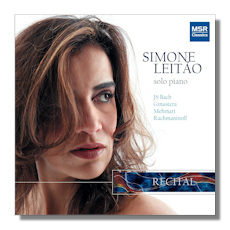
The Internet's Premier Classical Music Source
Related Links
-
Bach Reviews
Ginastera Reviews
Rachmaninoff Reviews - Latest Reviews
- More Reviews
-
By Composer
-
Collections
DVD & Blu-ray
Books
Concert Reviews
Articles/Interviews
Software
Audio
Search Amazon
Recommended Links
Site News
 CD Review
CD Review
Solo Piano Recital

Europe & South America
- Johann Sebastian Bach: English Suite #3 in G minor
- Alberto Ginastera: Piano Sonata #1, Op. 22
- André Mehmari: Grande Baião de Concerto
- Sergei Rachmaninoff: Piano Sonata #2, Op. 36 (1931 revision)
Simone Leitão, piano
MSR Classics MS1405 62:15
Summary for the Busy Executive: Sparks.
The popular mind tends to force the hot-blooded Latin-American stereotype (think of Dolores del Rio or the "forbidden dance," the lambada) and to forget cool customers like Borges, for example. Beyond film stars and dance rhythms, even concert pianists tend to fit this mold: João Carlos Martins and Martha Argerich, for example. Now comes along Simone Leitão, a pianist of exotic gorgeousness (glamor photos in the liner notes) who can play the bejeezus out of almost everything she touches. It will take a good deal of my self-control not to go all fan-boy over her.
In many ways, the stereotype is just that. These three pianists do differ, because all three play and interpret in their own way. The only thing they share – and it's not nothing – is that they tend to play passionately, but then so do many pianists not from South America. Martins's chief trait was power (crippling illness forced him to retire as a pianist) and at times a Gould-like arbitrariness, especially in his magnificent Bach recordings – and it usually worked. Argerich seems in the grip of her own nervous intelligence.
Leitão comes across, at least on this disc (the only thing I've heard), as primarily a superior singer on the keyboard, although she certainly has fingers. I like about her that I can't predict what she'll do at any given time, although the results run to the arresting rather than to the bizarre. Her Bach, for instance, has a highly improvisatory quality to it, as if she's deciding on the spot, and yet the interpretation comes over as a whole thing. Although a very different pianist, more instinctual than considered in her Bach, she puts me in mind of Angela Hewitt for that reason only. Her touch occasionally borders on the heavy, but overall she dances lightly. This came as a surprise in the Ginastera, normally a piece that pianists like to pound. The first sonata has always reminded me of Bartók's 1926 Sonata – the same powerful concentration of ideas, relentless drive, and generally stern mood. However Leitão finds its lyricism, even in its demonic energy.
As a palate-cleanser, Leitão gives us a three-part suite-cum-fantasy by young Brazilian composer André Mehmari. The composer wants to evoke Sertão, essentially the Brazilian outback, drier than the rest of the country and filled with a lot of scrub vegetation. The first part gives you the hollowness of the place, while the second finds its pastoral poetry. The third, a rhythmically tricky toccata, mainly celebrates in a jazzy, samba-like way until it returns to the sparseness of the opening. Mehmari gives the pianist lots to do in terms of color and interpretation, and he wrote it for Leitão. She plays the work like a champion, achieving a performance so good Mehmari should show his gratitude by at least sending her something nice.
I happen to like Rachmaninoff and always want to root for him, even in his weaker pieces, which one can fairly call the second piano sonata. The composer himself sensed this. He completed the original version in 1913 but revised it in 1931, mainly by gouging out and discarding clumps of it. It's one of those works where he found himself between a rock and a hard place. The version #1 sprawls, but it makes more sense than version #2, which just natters. I've never heard a performance of either version that made the music achieve coherence, even from some very high-powered pianists. Vladimir Horowitz, I believe, came up with his own version, but that too fizzles like ginger ale gone flat. Most of the problem comes down to two things: lack of material interesting in itself and the drowning of interesting material in too many superfluous lines. The piano writing gets at times fussy, something Rachmaninoff avoids in his concerti, despite their obvious virtuosity. Rachmaninoff the pianist, infected by some bad late-Nineteenth-Century keyboard habits, sabotages Rachmaninoff the composer. The most effective moments come at moments of relative textural simplicity. Leitão does what she can in the tolling first movement, trying to pick out the main melodic ideas from welters of notes. She's most consistently effective in the second movement, where the composer gives her some help by laying back, and she delivers an exciting finish in the third. Overall, however, she doesn't change my mind, despite some beautiful pianism.
But I don't resent her for it. The difficulty, perhaps the impossibility, breaks her and others. The rest of the program amply demonstrates this is a musician with real personality. She seems made of music.
Copyright © 2014, Steve Schwartz




















